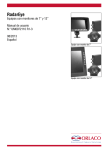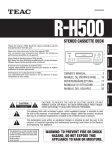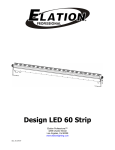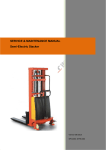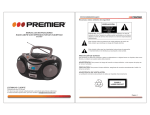Download VIETA HAM75 Technical data
Transcript
ÍNDICE ÍNDICE 02 INSTRUCCIONES DE SEGURIDAD 03 CONEXIONES DEL PANEL FRONTAL 08 INFORMACIÓN IMPORTANTE 04 ENTRADAS DEL PANEL TRASERO 09 CONEXIÓN ELÉCTRICA 05 CONEXIONES DEL PANEL TRASERO 10 INSTALACIÓN DEL MANDO A DISTANCIA 06 RESOLUCIÓN DE PROBLEMAS 11 FUNCIONAMIENTO DEL MANDO A DISTANCIA 07 FICHA TÉCNICA 12 02 Instrucciones de seguridad Un triángulo con el símbolo del rayo avisa al usuario de que el "voltaje peligroso" sin aislamiento de la carcasa supone un riesgo de descarga eléctrica. Un triángulo con el símbolo de exclamación aconseja al usuario que estudie las instrucciones importantes sobre el uso y mantenimiento de la unidad que aparecen en el manual suministrado junto a ésta. Símbolo para CLASS II (aislamiento doble). ADVERTENCIA: PARA REDUCIR EL RIESGO DE INCENDIO O DESCARGA ELÉCTRICA, NO EXPONGA ESTE EQUIPO A LA LLUVIA NI A LA HUMEDAD. NO ABRA LA CARCASA YA QUE SU VOLTAJE ES PELIGROSO. SÓLO EL PERSONAL CUALIFICADO ESTÁ AUTORIZADO PARA DESEMPEÑAR LABORES DE REPARACIÓN Y SERVICIO. PRECAUCIÓN: Si el enchufe del cable de suministro tiene que ser sustituido, es importante que el nuevo sea idéntico al anterior, o que éste haya sido recomendado por el fabricante. PARA EVITAR DESCARGAS ELÉCTRICAS, ES IMPORTANTE QUE INTRODUZCA CORRECTAMENTE EL ENCHUFE EN LA TOMA. 03 INFORMACIÓN IMPORTANTE Instrucciones de uso Condensación - Los paneles superior y trasero de la unidad pueden calentarse después de un uso prolongado. Esto no es debido a un fallo. - Desconecte la unidad cuando no la esté usando. Se puede producir condensación en los siguientes casos: - Cuando se traslada la unidad desde un lugar frío directamente a uno cálido. - Cuando se usa la unidad en un lugar donde acaba de encenderse un radiador o donde el aire frío del aire acondicionado llega directamente a la unidad. Proteja el cable eléctrico - Siga las instrucciones facilitadas para evitar un mal funcionamiento, descargas eléctricas, incendio o daños personales: - Sujete el enchufe firmemente cuando lo introduzca en la toma. - Evite dispositivos que generen calor. - No coloque objetos sobre el cable de suministro eléctrico. - No realice trabajos encima de la unidad ni cambie el cable de suministro eléctrico. - Si se utiliza la unidad en verano en una habitación húmeda y calurosa y anteriormente se ha trasladado la unidad desde una habitación con aire acondicionado. - Si hay vapor o un alto nivel de humedad en la habitación. En caso de condensación, la unidad no funcionará correctamente. Desconecte la unidad. Desenchufe la unidad y espere 2-3 horas. La unidad se adaptará al ambiente y la condensación habrá desaparecido. Situación No coloque la unidad en los siguientes lugares: - Bajo el sol, cerca de dispositivos que desprendan calor o en espacios cerrados. - Lugares con temperatura elevada (40C o más) o con alta humedad relativa (90% o más). - En lugares sucios, ya que pueden dañarse las partes internas. No ponga sus dedos ni ningún otro objeto dentro de la unidad - Es peligroso tocar las partes del interior y puede causar daños o lesiones. No abra la carcasa. - No coloque cuerpos extraños en la unidad. Interferencia Colocar la unidad cerca de un televisor, radio o vídeo puede causar una mala calidad de sonido e imagen. Si esto ocurre, aleje la unidad del televisor, radio o vídeo. 04 CONEXIÓN ELÉCTRICA Conexión eléctrica 220-240V AC~50Hz No conecte la unidad a la red eléctrica hasta que las conexiones hayan sido correctamente realizadas. Compruebe que todas las conexiones se han realizado correctamente antes de encender el equipo. Compruebe que el voltaje eléctrico es 220-240V CA 50Hz antes de encender el equipo. Conexión eléctrica Compruebe que el resto de conexiones se ha realizado correctamente antes de introducir el enchufe en la toma de la pared. Introduzca el enchufe en la toma apropiada. Si va a usar la unidad en el extranjero, quizás necesite un adaptador. 05 INSTALACIÓN DEL MANDO A DISTANCIA Inserción de las pilas 1 Retire la tapa conforme aparece en el dibujo. 3 Retire la tapa. 2 Coloque dos pilas del tipo AAA/R03/UM4 en el compartimento de pilas. Asegúrese de que la orientación de las mismas es la adecuada (vea la imagen debajo). - No mezcle pilas nuevas y usadas, ni de diferente tipo. - Si el mando a distancia no se utiliza durante un periodo prolongado, retire las pilas para evitar su corrosión. Cómo usar el mando a distancia Máximo 6m Dirija el mando al sensor que está en el panel frontal de la unidad. Cuando se reciba la señal del mando a distancia, la unidad ejecuta la función solicitada. El mando funciona a una distancia de 6 metros. - En ocasiones el mando no funciona cuando hay mucha luz. Deberá desplazar la unidad si esto ocurre. - El mando puede funcionar mal cuando se utiliza cerca de la unidad. - No coloque objetos sobre el mando, ya que las baterías pueden descargarse si se pulsa una tecla prolongadamente. - Asegúrese de que no hay objetos entre el mando y la unidad. - No coloque la unidad tras un cristal polarizado ya que puede reducir la distancia máxima de funcionamiento del mando. 06 FUNCIONAMIENTO DEL MANDO A DISTANCIA Funciones del mando a distancia Para HCD30B: 1. Power (botón de encendido): activa en standby las unidades HCD30B, HAM50B/HAM75B. 2. Eject (botón de expulsión): abre y cierra la bandeja del disco del CDP-100 Botones numerados (0,1,2...9~+10): selecciona las pistas en el HCD30B. Nota: <la tecla +10 puede ser pulsada mediante 10+(ej. 10, pulse botón +10 y botón 0; ej. 15, pulse botón +10 ybotón 5 para seleccionar la pista 15), y 10x (ej. 25, pulse dos veces +10 y el botón 5.) 4. Fast forward (Avance rápido): avance rápido en la reproducción del HCD30B 5. PLAY/PAUSE (Reproducción/pausa): inicia e interrumpe la reproducción. 6. Skip (Saltar) (>>I) / Next (Siguiente): selecciona la pista siguiente 7. Skip (Saltar) (I<<) / Previous (Anterior): selecciona la pista anterior. 8. REPEAT (Repetición): repite una o todas las pistas de un CD o USB. 9. Random (Modo aleatorio): las pistas se reproducen en orden aleatorio. 10. Fast reverse (retroceso rápido): rebobinado durante la reproducción del HCD30B. 11. TIME (tiempo): pulsando este botón, aparece - actual track (pista actual): elapsed time (tiempo transcurrido) - actual track remaining time (tiempo restante de la pista actual) - actual track (pista actual): elapsed time of full disk (tiempo transcurrido del disco completo) - actual track (pista actual): remaining time of full disc (tiempo restante del disco completo) 12. STOP (Parada): detiene la reproducción 3. Para HAM50B/HAM75B: 13. CD/USB: para activar las unidades HCD30B y HAM50B/HAM75B, y, cambie del modo de reproductor de CD a reproductor de USB; posición opuesta. 14. DVD: activa el DVD. 15. SINTONIZADOR: activa el sintonizador. 16. AUX: activa la fuente de Phono. 17. Phono: activa la fuente de Phono. 18. Line In (Entrada de línea): Para activar la entrada de línea (conector de 3,5 mm en el panel frontal) 19. SPKRS A/B (Altavoces A/B): selector de altavoz, para elegir los altavoces par-A o par-B. Nota: existen 4 modos en el botón de selección de altavoz (también en el mando a distancia): Pulsar 1ª vez (configuración predeterminada): Control del altavoz A; Pulsar 2ª vez: Control del altavoz B; Pulsar 3ª vez: Control de altavoz A y B, conecta ambos; Pulsar 4ª vez: Control de altavoz A y B, desconecta ambos. ...repetir... 20. MUTE (Silencio): modo de silencio. 21. Function (Función): ejecuta el menú de HAM50B/HAM75B, para ajustar el bajo, el agudo y el balance 22. Disminución de volumen: disminuye el volumen 23. Aumento de volumen: aumenta el volumen Ciertas funciones sólo pueden realizarse mediante el mando a distancia. Ciertas funciones están conectadas a la fuente de entrada de la señal elegida. Debido a ello puede que algunos botones del mando a distancia no estén disponibles si no se selecciona la correspondiente fuente de entrada de señal. 07 CONEXIONES DEL PANEL FRONTAL Entrada del panel frontal: 1. Conmutador de energía: enciende y apaga la unidad. 2. LED: la luz se apaga cuando se enciende el HAM50B/HAM75B; en el modo standby se enciende una luz azul. 3. Sensor: recibe la señal del rayo infrarrojo cuando se opera el mando a distancia. 4. BASS (Bajos): aumenta o disminuye los bajos (baja frecuencia). 5. TREBLE (Agudos): aumenta o disminuye los agudos (alta frecuencia). 6. Balance: selecciona el canal Right (derecho) o Left (izquierdo) de un par de altavoces conectados. Nota: si gira el botón hasta su tope izquierdo o derecho, el otro canal no tendrá sonido. 7. Mando del Volumen Aumenta o disminuye el volumen. 8. Speaker A/B (Altavoz A/B): selector de altavoz, para elegir los altavoces par-A o par-B. Nota: existen 4 modos en el botón de selección de altavoz (también en el mando a distancia): Pulsar 1ª vez (configuración predeterminada): Control del altavoz A; Pulsar 2ª vez: Control del altavoz B; Pulsar 3ª vez: Control de altavoz A y B, conecta ambos; Pulsar 4ª vez: Control de altavoz A y B, desconecta ambos. ...repetir... 9. CD: activa el DVD. 10. DVD: activa el DVD. 11. TUNER/AUX (Sintonizador/Aux): pulse una vez para activar el SINTONIZADOR; pulse una 2ª vez para activar la fuente de AUX; ...repetir... 12. PHONO (Fono): activa la fuente de PHONO. 13. Line In (Entrada de línea): activa la fuente de Entrada de Línea. 14. Line In (Entrada de línea): fuente de miniconector de 3,5mm, como reproductor de MPS, iPod, iPhone, etc. 15. Auriculares: conector de clavija de 6mm. 08 ENTRADAS DEL PANEL TRASERO Entradas del panel trasero: 1. Salida de Línea: para conectar un amplificador externo 2. Entrada de CD: para conectar un reproductor de CD (se recomienda el modelo HCD30B) o un equipo opcional. 3. Entrada de DVD: para conectar un reproductor de DVD o un equipo opcional. 4. Entrada de Sintonizador: para conectar un Sintonizador o un equipo opcional. 5. Entrada Auxiliar: para conectar el equipo opcional de terceros 6. Entrada de PHONO: para conectar un plato con un cartucho phono MM Nota: Las entradas superiores del Tornillo de Tierra deben estar conectadas mientras tanto. 7. Altavoz A Izquierdo & Derecho: para conectar el par A de altavoces a 4-8 ohm. 8. Altavoz B Izquierdo & Derecho: para conectar el par B de altavoces a 4-8 ohm. Nota: Cuando quiera conectar los dos pares de Altavoces. A&B simultáneamente, la impedancia máxima de los altavoces debe ser de 8 ohm o superior. 9. Entrada CA: para conexión de voltaje del suministro. Salidas de Altavoz Izquierdo y Derecho Para no dañar el amplificador, compruebe que NO está conectado a una salida CA cuando conecte o desconecte el cable del altavoz a las salidas del altavoz. El amplificador tiene dos pares de salidas de altavoz en la parte posterior, con las indicaciones Speaker Left (Altavoz Izquierdo) y Speaker Right (Altavoz Derecho). Utilice el cable de altavoz apropiado y conecte el altavoz derecho (del Altavoz A o B) a los conectores del Altavoz Derecho y el altavoz izquierdo a los conectores del Altavoz Izquierdo (del Altavoz A o B). Es importante que los terminales negativo (negro) y positivo (rojo) de sus altavoces coincidan con los terminales positivo (rojo) y negativo (negro) del amplificador. 09 CONEXIONES DEL PANEL TRASERO Conexiones del panel trasero: Asegúrese de que el Conmutador de Energía situado en la parte delantera del amplificador está en la posición off (apagado). Introduzca el enchufe (enchufe IEC) del cable eléctrico suministrado con el amplificador dentro de la toma (ENTRADA AC) en la parte posterior de la unidad. Asegúrese de que está bien ajustado. Introduzca el otro extremo del cable eléctrico en una toma CA de pared. Speaker B (Altavoz B) Speaker A (Altavoz A) Turntable (Plato) R R L Nota: Cuando desee conectar los dos pares de Altavoces. A&B simultáneamente, la impedancia máxima de los altavoces debe ser de 8 ohm o superior. VCR Sintonizador DAB/FM Subwoofer eléctrico (Opcional) Reproductor de DVD Reproductor de CD Altavoces Amplificador 10 L RESOLUCIÓN DE PROBLEMAS PROBLEMA CAUSA/SOLUCIÓN El amplificador está encendido pero no tiene energía. - Conecte la unidad a la toma de corriente eléctrica. - Compruebe que el enchufe se ha introducido correctamente en la toma. - El fusible interno se ha fundido y un técnico de servicio autorizado debe sustituirlo. No hay sonido. - El cable de electricidad está dañado y debe ser sustituido. - El amplificador no ha sido encendido. -El control de volumen está en el mínimo. - Los cables del altavoz no han sido conectados correctamente. - Ha seleccionado la fuente de entrada equivocada. - No ha conectado la fuente de entrada. Sólo hay sonido en un canal. - Los cables del altavoz o de entrada de audio están dañados o han sido conectados de modo incorrecto. - La fuente de entrada está defectuosa. - Los altavoces están defectuosos. Zumbido fuerte. - Los cables de entrada de audio están dañados o han sido conectados de modo incorrecto. - El cable de tierra del tocadiscos no ha sido conectado. - El brazo del tocadiscos está defectuoso. Baja intensidad de bajos y mala calidad del efecto estéreo - La conexión del altavoz está fuera de fase. Compruebe que los polos negativo y positivo han sido conectados correctamente, tanto en la parte posterior del amplificador como en la parte posterior del altavoz. Sonido distorsionado - Algún cable conductor del cable del altavoz está en contacto con otro, lo que produce la distorsión del sonido. - El volumen está demasiado alto. La unidad no cambia entre modos de entrada - El amplificador está defectuoso y debe repararlo un técnico cualificado. 11 FICHA TÉCNICA Para HAM50B: Para HAM75B: Entrada de PHONO: Impedancia de entrada Sensibilidad de entrada 47 KOhm 10.0 mV Entrada de Phono: Impedancia de entrada Sensibilidad de entrada 47 KOhm 10.0 mV Entradas de nivel de línea Impedancia de entrada Sensibilidad de entrada 47 Kohm 400 mV Entradas de nivel de línea Impedancia de entrada Sensibilidad de entrada 47 Kohm 500 mV Salidas de nivel de línea Salida de línea de impedancia de salida Auriculares 10 KOhm 32 Ohm Salidas de nivel de línea Salida de línea de impedancia de salida Auriculares 10 KOhm 32 Ohm Nivel máximo de salida de salida de línea Auriculares 250 mV 2.0 V Nivel máximo de salida de salida de línea Auriculares Control de tono 250 mV 2.0 V Control de tonalidad Agudos: +/- 14dB Agudos: +/- 14dB Bajos +/- 14dB Bajos +/- 14dB Potencia de salida 2 x 30 W en 4 Ohm Respuesta de frecuencia: 10Hz a 80KHz (-3dB) Distorsión Respuesta de frecuencia: <0,2% Relación señal-ruido> Dimensiones: Potencia de salida 10Hz a 80KHz (-3dB) Distorsión 80dB <0,2% Relación señal-ruido> H70 x W430 x D285 mm Peso neto: 2 x 50 W en 4 Ohm Dimensiones: 5,7kg 80dB H70 x W430 x D285 mm Peso Neto: Accesorios suministrados: 1. Manual de usuario 2. Distribución Eléctrica 3. Mando a distancia Nos reservamos el derecho a modificar la ficha técnica y el diseño del producto sin previo aviso como consecuencia de futuras mejoras del producto. 12 6,3 kg CONTENTS CONTENTS 02 SAFETY PRECAUTIONS 03 FRONT PANEL CONNECTIONS 08 IMPORTANT INFORMATION 04 BACK PANEL INTRODUCTIONS 09 CONNECTION TO THE MAINS 05 BACK PANEL CONNECTIONS 10 REMOTE CONTROL INSTALLATION 06 TROUBLESHOOTING 11 REMOTE CONTROL OPERATIONS 07 TECHNICAL DATA 12 02 SAFETY PRECAUTIONS A triangle with a lightning symbol draws the user's attention to "dangerous voltage" without insulation in the cabinet which may be high enough to entail a risk of electric shock. A triangle with an exclamation mark draws the user's attention to important instructions for use and maintenance in the accompanying manual, which should be studied. A symbol for CLASS II (double insulation) WARNING: TO MINIMISE THE RISK OF FIRE OR ELECTRICAL SHOCK, DO NOT EXPOSE THE UNIT TO RAIN OR MOISTURE. DO NOT OPEN THE CABINET AS IT CONTAINS DANGEROUS VOLTAGE. ONLY QUALIFIED TECHNICIANS ARE ALLOWED TO CARRY OUT REPAIR AND SERVICE. CAUTION: if the plug of the power cord needs to be replaced, it is important that the replacement is identical to the plug to be replaced, or that the new plug has been recommended by the manufacturer TO AVOID ELECTRICAL SHOCK, IT IS IMPORTANT TO INSERT THE PLUG CORRECTLY INTO THE SOCKET. 03 IMPORTANT INFORMATION Handling instructions Condensation - The top and back panel of the unit may become warm after prolonged use. This is not due to a defect. - Turn off the power when the unit is not used. Condensation may occur in the following cases: - When the unit is moved directly from a cold to a warm place. - When the unit is used in a room where the radiator has just been switched on or a place where the cold air from the air-conditioning system is directed at the unit. Protect the power cord - Follow the instructions below to prevent abnormal operation, electrical shock, fire or personal injury: - Hold the plug firmly when inserting it into the socket. - Avoid heat-producing devices. - Do not place objects on the power cord. - Do not carry out service work on or change the power cord. - If the unit is used in the summer in a warm and humid room just after it has been moved from an air-conditioned room. - If there is steam or a high level of humidity in the room. In case of condensation, the unit will not work properly. Turn off the unit. Unplug the unit and leave it for 2-3 hours. The unit will then have adapted to the environment and any condensation will have disappeared. Positioning Do not place the unit in any of the fol. places: - In sunlight, close to heat-producing devices or in an enclosed rack. - In places with high temperatures (40C or more) or high relative humidity (90% or more). - In dirty places as some internal parts may be damaged. Do not put your fingers or any other objects into the unit - Touching the internal parts is dangerous and may cause injury or damage. Do not open the cabinet. - Do not place any foreign matter in the unit. Interference Placing the unit near a television set, radio or video player may cause poor picture and sound quality. In that case, move the unit further away from the television set, radio or video player. 04 CONNECTION TO THE MAINS Connection to the mains HAM75B 150W USE ONLY WITH 250V FUSE FUSE:T2A L 250V 220-240V AC~50Hz Do not turn on the power before all connections have been made correctly. Check that all connections have been made correctly before turning on the power. Check that the mains voltage is 220-240V AC50Hz before turning on the power. Connection to the mains Check that all other connections have been made correctly before inserting the mains plug into the wall socket. Then insert the plug into a suitable socket. If the unit is to be used abroad, you may need an adapter. 05 REMOTE CONTROL INSTALLATION Installation of batteries 1 Remove the cover as illustrated. 3 Replace the cover. 2 Position two batteries of the type AAA/R03/UM4 in the battery compartment. Make sure that the orientation of the batteries is correct (see drawing at bottom). - Do not mix new and old batteries and do not use different types of batteries. - If the remote control is not used for prolonged periods, remove the batteries from the remote control to avoid corrosion. Using the remote control Direct the remote control at the sensor on the front panel of the unit. When the remote control signal is received, the unit reacts accordingly. The remote control works within a range of 6 metres. HA M7 5B HE AD PH ON E - Sometimes the remote control does not work well in strong light. You may have to move the unit if it is a problem. - Malfunction may occur if other remote controls are used near the unit. - Do not place any objects on the remote control, as the batteries may become flat if a key is depressed constantly. - Make sure that there are no obstacles between remote control and unit. - Do not position the unit behind tinted glass as it may reduce the maximum range of the remote control. 06 REMOTE CONTROL OPERATIONS Remote control functions For HCD30B operations: 2 1 Note: +10 key could be pressed by 10+(e.g.10, press +10, button and 0 button; e.g.15, press +10 button and 5 button to select track 15), and 10x (e.g.25, by 2 times pressing +10 and 5 button.) 3 4 0 5 7 RANDOM 9 TIME STOP 11 6 8 10 12 CD/USB 14 13 15 16 PHONO 4. Fast forward: Fast forwards in playback on HCD30B 5. Play/Pause:Starts and pause playback. 6. Skip (>>I) / Next: Selects the next track 7. Skip (I<<) / Previous: Select the previous track. 8. Repeat: Repeat a single or all tracks on CD disc or USB. 9. Random: All tracks are played in random order. 10. Fast reverse: Rewinds in playback on HCD30B. 11. TIME: Press the key by times, shows - actual track : elapsed time - actual track : remaining time - actual track : elapsed time of full disk - actual track : remaining time of full disc 12. Stop: Stop playback LINE IN 17 18 19 20 ----------------------------------------------------------------------------------- For HAM50B/HAM75B operations: 21 22 1. Power: Set HCD30B, HAM50B/HAM75B into standby. 2. Eject: Open and close the disc tray on CDP-100 3. Number buttons (0,1,2...9 ~+10): selects tracks on HCD30B. 23 13. CD/USB: To activate HCD30B and HAM50B/HAM75B, and, switch the CD playback to USB playback; oppositely switch. 14. DVD: To activate DVD source. 15. TUNER: To activate Tuner source. 16. AUX: To activate Phono source. 17. PHONO: To activate Phono source. 18. LINE IN: To activate line in source (3.5mm jack in front panel) 19. SPKRS A/B: Speaker selector, to choose pair-A or pair-B speakers to listen. Note: there's 4 modes in the speaker selecting button (either in remote control): Press 1st time (Default): Drive speaker A; Press 2nd time: Drive speaker B; Press 3rd time: Drive speaker A and B both on; Press 4th time: Drive speaker A and B both off. ...again... 20. Mute: Mutes the sound. 21. Function: Enters the menu on HAM50B/HAM75B, where it is possible to adjust bass, treble and balance. 22. Volume decrease: Turns down the volume. 23. Volume increase: Turns up the volume. Some of the functions of the unit can only be performed by means of the remote control. Some functions are connected with the selected signal input source. Some buttons on the remote control may therefore not be available if the corresponding signal input source has not been selected. 07 FRONT PANEL CONNECTIONS Front panel introduction: HAM75B HEADPHONE 1 2 3 4 5 6 7 8 9 10 10 11 12 13 14 1. 2. 3. Mains switch: Used to turn ON/OFF the power. LED: Lights off when HAM50B/HAM75B turns on, lights blue when in standby mode. Sensor: For getting the infrared ray signals of remote control operations. 4. 5. 6. Bass: Selects for adjusting the bass (low frequency) up or down. Treble: Selects for adjusting the treble (high frequency) up or down. Balance: Selects for adjusting Right or Left channel of one pair of connected speakers. Note: if turn the Right or Left to the end, the other channel will be no sound. 7. 8. Volume knob: Turns up or down the volume.. Speaker A/B: Speaker selector, to choose pair-A or pair-B speakers to listen. Note: there's 4 modes in the speaker selecting button (either in remote control): Press 1st time (Default): Driver speaker A; Press 2nd time: Driver speaker B; Press 3rd time: Driver speaker A and B both on; Press 4th time: Driver speaker A and B both off. ...again... 9. CD: To activate CD source. 10. DVD: To activate DVD source. 11. TUNER/AUX: Press 1st time to activate TUNER source; press 2nd time to activate AUX source; ...again... 12. PHONO: To activate PHONO source. 13. LINE IN: To activate LINE IN source. 14. Line in: 3.5mm mini jack source, like MP3 player, iPod, iPhone, etc. 15. Headphone: 6mm jack connector. 08 BACK PANEL INTRODUCTIONS Back panel introductions: HAM75B 150W USE ONLY WITH 250V FUSE FUSE:T2A L 250V 1 4 2 3 5 7 6 8 9 1. Line Out: For connection to an external amplifier 2. Input CD: For connection of CD player (recommend HCD30B) or optional equipment. 3. Input DVD: For connection of DVD player or optional equipment. 4. Input Tuner: For connection of Tuner or optional equipment 5. Input AUX: For connection of someone optional equipment 6. Input PHONO: For connection of a turntable with an MM phono cartridge Note: Ground Screw above inputs must be connected meanwhile. 7. 8. Speaker.A Left & Right: For connection to A pair of loudspeakers at 4-8 ohm. Speaker.B Left & Right: For connection to B pair of loudspeakers at 4-8 ohm. Note: When you want to connect the 2 pairs of Speaker. A&B simultaneously, the maximum impedance of speakers must be 8 ohm or above. 9. AC Input: For connection of mains voltage. Speaker Outputs Left and Right To avoid damage to the amplifier, make sure it is NOT plugged into an AC outlet while connecting up or disconnecting speaker wire to the speaker outputs. The amplifier has two pair of speaker outputs on the back labeled Speaker Left and Speaker Right. Using a suitable speaker wire, connect the right speaker (of Speaker A or B) to the Speaker Right connectors and the left speaker to the Speaker Left (of Speaker A or B) . Pay careful attention to match the positive (red) and negative (black) terminals on your speakers to the positive (red) and negative (black) terminals on back of the amplifier. 09 BACK PANEL CONNECTIONS Back panel connections: Check that the Power Switch on front of the amplifier is in the off position. Push the plug (IEC line socket) of the power cable supplied with the amplifier into the socket (AC INPUT) on back of the unit. Make sure it is pressed in firmly. Plug the other end of the power cable into an AC wall outlet. HAM75B 150W US E ON LY W IT H 25 0V F US E FUSE:T2A L 250V Speaker B Turntable Speaker A R R L L Note: When you want to connect the 2 pairs of Speaker. A&B simultaneously, the maximum impedance of speakers must be 8 ohm or above. VCR DAB/FM Tuner Powered subwoofer (Optional) PO WE R DVD Player CD Player HC D3 0B Speakers Slave amplifier PO WE R 10 TROUBLESHOOTING PROBLEM No power when the amplifier is turned on. No sound. There is sound in one channel only. High buzzing. Weak bass and poor stereo perspective Distortion of sound The unit does not switch between input modes CAUSE/REMEDY -Switch on the electric current at the socket. -Check that the plug has been correctly inserted into the socket. -The internal fuse has blown and must be replaced by a qualified service technician. -The power cord has been damaged and must be replaced -The amplifier has not been turned on. -The volume control is set at a minimum. -The speaker cables have not been correctly connected. -A wrong input source has been selected. -No input source has been connected. -The audio input cables or speaker cables have been incorrectly connected or damaged. -The input source is defective. -The speakers are defective. -The audio input cables have been incorrectly connected or damaged. -The ground cable for the record player has not been connected. -The record player pick-up is defective. -The speaker connection is out of phase. Check that the positive and negative poles have been correctly connected, both at the back of the amplifier and at the back of the speaker. -Some of the conductor wires of the speaker cable are in contact with each other which causes distortion. -The volume is set too high. - The amplifier is defective and should be serviced by a qualified technician. 11 TECHNICAL DATA For HAM75B: For HAM50B: Phono input Input impedance Input sensitivity 47 KOhm 10.0 mV Phono input Input impedance Input sensitivity 47 KOhm 10.0 mV Line level inputs Input impedance Input sensitivity 47 Kohm 400mV Line level inputs Input impedance Input sensitivity 47 Kohm 500mV Line level outputs Output impedance Line out Headphones Maximum output level Line out Headphones Tone control Treble Bass Line level outputs Output impedance Line out Headphones 10 KOhm 32 Ohm 250mV 2.0 V Maximum output level Line out Headphones Tone control Treble Bass +/- 14dB +/- 14dB Output power 2 x 30 Watt at 4 Ohm Output power 10 KOhm 32 Ohm 250mV 2.0 V +/- 14dB +/- 14dB 2 x 50 Watt at 4 Ohm Frequency response: 10Hz to 80KHz (-3dB) Frequency response: 10Hz to 80KHz (-3dB) Distortion: <0.2% Distortion: <0.2% Signal/noise ratio: >80dB Signal/noise ratio: >80dB Dimensions: H70 x W430 x D285 mm Dimensions: H70 x W430 x D285 mm Net Weight: 5.7kg Net Weight: 6.3 kg Supplied Accessories: 1. User manual; 2. Mains Lead; 3. Remote Control. We reserve the right to change the technical data and the design of the product without notice as a result of further development. 12
This document in other languages
- español: VIETA HAM75




























